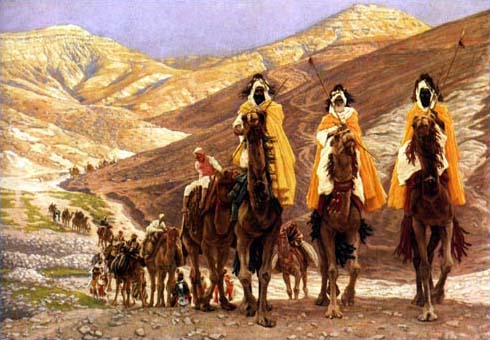19 Dec. The 'wise men' follow the star to Bethlehem
"Then Herod had a secret meeting with the wise men and learned from them the exact time they first saw the star [that indicated to them the birth of a new 'King of the Jews']."
"He sent the wise men to Bethlehem [where the chief priests had told him the 'Messiah' or 'Christ' would be born], saying, 'Look carefully for the child. When you find him, come and tell me so I can worship him too'."
"After the wise men heard the king, they left [Jerusalem]. The star that they had seen in the east went before them until it stopped above the place where the child was [in Bethlehem]."
(Matthew 2:7-9)

King Herod (who was not a Jew himself) consulted the Jewish chief priests over the prophesies concerning the 'Messiah' or 'Christ' (the 'anointed one') (see Micah 5:2), and sent the 'magi' or ‘wise men’ to Bethlehem (5 miles / 8 kms south of Jerusalem) to search for this ‘rival’ to his throne.
The 'wise men' left Herod's Palace in Jerusalem, and followed the star they had seen in the east until they arrived in Bethlehem.
These 'magi' were probably part of a group of travelling merchants. Like many other traders selling exotic goods in Jerusalem, they came from ‘the east’ – probably from Babylonia or Persia.
Traditionally called ‘wise men’, these 'magi' were astronomers who recorded the detailed movements of the stars, but were also astrologers who looked for ‘portents’ or ‘signs’ in the patterns and movements of the stars to predict the birth and death of kings. As Zoroastrians, they shared the Jewish belief in one God, and they also believed in a Messiah who would come down from heaven. When they arrived in Jerusalem, they congratulated Herod the Great (the ‘King of the Jews’) because they had seen a star that indicated an heir to the Jewish throne had been born.
No one is sure exactly what the magi saw in the sky signifying to them this important royal birth. But there is no doubt that whatever the Star of Bethlehem was, it also had great astrological significance.
Many theories have been proposed regarding the nature of the Star of Bethlehem. Some believe it was a comet. A ‘broom star’ (a comet with a tail) was, indeed, recorded by Chinese astronomers in the spring of 5BC. But comets were always associated with doom and disaster.
Some believe it was a star exploding spectacularly in its ‘supernova’ phase. But this would have had no known astrological significance.
Others believe the ‘star’ was actually a planet – possibly Jupiter, regarded as the ‘kingmaker’ planet by astrologers in Jesus’s day.
An ancient clay tablet from Babylon – now in the British Museum – records a very rare ‘triple conjunction’ of the planets Jupiter and Saturn in the night sky in May, September and November of 7BC. As the two planets moved behind each other on three occasions, this would have looked like a bright star to observers in Babylon.
Furthermore, these conjunctions happened within the constellation of Pisces – a sign of the Zodiac associated at that time with Israel. To religious people in Babylon, the conjunctions may well have signified the birth of a new king in Israel, and they may have set out on a trading expedition to Jerusalem armed with expensive merchandise and costly gifts.
The ‘star’ would have moved from east to west across the night sky, and as the planets were moving independently of the other stars in the constellation of Pisces, they might even have appeared to ‘hover’ over Jerusalem or go south towards Bethlehem for some time after the conjunctions.
The photo shows an artistic impression of the journey of the magi.
You can read more about Herod's plot to kill the infant Jesus @ https://www.thebiblejourney.org/the-bible-journey/3-jesuss-childhood-journeys-b/wise-men-visit-jerusalem/
